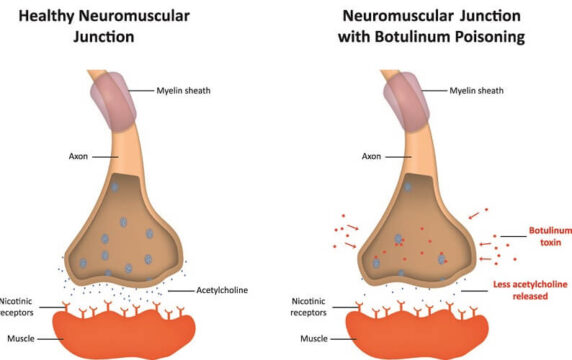Mechanism of Action Explained
Botox® and similar neuromodulators (e.g., Dysport®, Xeomin®, Nuceiva®) are purified forms of botulinum toxin type A. They are widely used to soften facial wrinkles and treat conditions like muscle spasms, migraines and excessive sweating. Understanding how these medications work helps patients appreciate their benefits, limitations and safety profile.

- Patients who understand how neuromodulators work can make informed decisions and realistic expectations. Recognizing that the toxin does not “erase” wrinkles but temporarily relaxes specific muscles helps clients appreciate why dosage and injection technique matter. It also clarifies why consistent follow‑up treatments are necessary to maintain results.
Botulinum Toxin and Neuromuscular Transmission
Muscles contract when nerves release the neurotransmitter acetylcholine at the neuromuscular junction. This chemical messenger binds to receptors on muscle fibers, triggering contraction. Botulinum toxin interferes with this process by preventing acetylcholine release, leading to temporary muscle relaxation [2].
Multi‑Step Mechanism of Action
The mechanism of botulinum toxin is a complex, multi‑step process involving:
- Binding: After injection, botulinum toxin binds selectively to high‑affinity receptors on cholinergic nerve terminals [2].
- Internalization: The toxin‑receptor complex is internalized into the nerve terminal via receptor‑mediated endocytosis. Once inside, the toxin’s light chain is released into the cytoplasm [2].
- Enzymatic cleavage: The light chain enzymatically cleaves SNAP‑25 (synaptosomal‑associated protein 25) and other SNARE proteins essential for synaptic vesicle fusion [1,2]. Without functional SNAP‑25, acetylcholine‑containing vesicles cannot fuse with the nerve cell membrane, so acetylcholine cannot be released [1].
Collectively, these steps block neuromuscular transmission, causing the injected muscle to relax. This effect is reversible: the nerve terminal eventually forms new synaptic connections and regains function.
Onset and Duration of Action
After injection, the initial effect of botulinum toxin typically appears within 24–72 hours and becomes fully evident after 4–7 days [2]. The muscle‑relaxing effect gradually wanes as new nerve terminals form, usually over 2–3 months, which is why maintenance treatments are needed [2].
Implications for Cosmetic and Medical Treatments
Knowing how neuromodulators work helps tailor doses and expectations. Small amounts can effectively reduce facial wrinkles like frown lines, forehead creases and crow’s feet without freezing natural expression. In medical contexts, neuromodulators relieve muscle spasticity, chronic migraines and excessive sweating. Because the effect is temporary, treatments can be adjusted as muscle strength and desired outcomes change.
Request Your Appointment Today
When administered by experienced professionals, botulinum toxin has a strong safety record. Possible short‑term effects include mild pain, swelling or bruising at injection sites. Rarely, transient headaches or flu‑like symptoms occur. The paralysis remains localized to the treated muscles, and the body eventually restores normal nerve function. Serious systemic side effects are extremely unusual when FDA‑ or Health‑Canada‑approved products are used correctly.
Read our privacy policy here